



Do you have a question about the Keysight N9010B and is the answer not in the manual?
Provides an overview of the EXA signal analyzer's capabilities, including its Windows Embedded Standard 7 OS and adaptability.
Details available options and measurement applications that can be purchased and installed.
Lists available accessories from Keysight Technologies to configure the analyzer for specific applications.
Tasks to complete before troubleshooting, including safety and ESD information.
Guidance on protection from electrostatic discharge and handling electronic components.
Lists required equipment for troubleshooting, adjusting, and testing the EXA Signal Analyzer.
Information on how to contact Keysight for support, including online resources and office contact details.
Procedure for returning the instrument for servicing, including failure descriptions and packaging.
A checklist of basic checks to perform before calling for service or returning the instrument.
Describes the signal analyzer boot-up process from initial AC power to a normal analyzer sweep.
Details potential problems that may occur during instrument boot-up due to internal hardware issues.
Procedures to verify signal level problems with input frequencies for both low and high band paths.
Explains the difference between Events (Error, Warning, Advisory) and Conditions (Detected/Cleared events).
Describes the three categories of severity: Errors, Warnings, and Advisories.
Provides information on useful advisory messages and their correction information.
Describes the RF section's purpose, major assemblies, and signal paths for various options.
Provides procedures for troubleshooting RF section problems, including quick checks and detailed steps.
Details RF section components and signal paths for millimeter-wave options.
Describes how to verify the low band signal path using an internal 50 MHz calibrator signal.
Provides troubleshooting steps for issues related to the low band signal path.
Describes how to verify the high band RF path using an internal 4.8 GHz calibrator signal.
Details troubleshooting steps for issues related to the high band RF path.
Describes the A15 Front End Controller board's functionality, assemblies, and options.
Provides troubleshooting procedures for the A15 Front End Control Assembly.
Details the A2 Analog I.F. Assembly description, theory of operation, and troubleshooting.
Details the A2 Analog IF and A3 Digital IF assemblies for 40 MHz bandwidth.
Describes the L.O. Synthesizer assembly's purpose, inputs, outputs, and tuning range.
Explains the theory of operation for the L.O. Synthesizer assembly, including major blocks.
Provides troubleshooting steps for the L.O. Synthesizer Assembly.
Describes the A16 Reference Assembly's purpose and signal sources.
Provides troubleshooting steps for the A16 Reference Assembly.
Describes the A4 Processor assembly, including disk drive, interface board, and connectors.
Troubleshooting steps for boot-up or initialization problems and BIOS settings.
Describes the A5 Disk Drive, its partitioning, and data backup recommendations.
Troubleshooting steps for software-related issues and disk drive replacement.
Procedure for restoring the original factory configuration of the system software.
Describes the A6 Power Supply assembly, its purpose, and output signals.
Basic troubleshooting steps for the A6 Power Supply with the cover on.
Describes the A7 Midplane board's purpose, connections, and power supply LEDs.
Troubleshooting steps for the A7 Midplane Assembly, including voltage checks.
Describes the Motherboard's function as an electrical link and its main functions.
Describes the A1 Front Frame Assembly components: Interface Board and LCD.
Provides graphic symbols used on block diagrams for understanding instrument architecture.
Detailed block diagram of the RF Lowband Path for input signals below 3.6 GHz.
Detailed block diagram of the RF Highband Path #1 for input signals 3.6 GHz to 13.6 GHz.
Detailed block diagram of the RF Highband Path #2 for input signals 13.6 GHz to 26.5 GHz.
Block diagram for millimeter-wave RF low frequency path for options 532, 544.
Block diagram for millimeter-wave RF highband path #1 for options 532, 544.
Block diagram for millimeter-wave RF highband path #2 for options 532, 544.
Block diagram for millimeter-wave RF highband path #3 for options 532, 544.
Block diagram illustrating the reference and synthesizer components.
Block diagram of the 25 MHz bandwidth Intermediate Frequency system.
Block diagram of the 40 MHz bandwidth Intermediate Frequency system.
Block diagram of the EXA computer system.
Introduces service capabilities accessed via System Settings and Spectrum Analyzer menus.
Describes the two levels of service access: Regular and Secure Service access.
Details how to access secure service capabilities using a Service Code.
Describes Timebase and Timebase DAC adjustments.
Information on accessing diagnostic capabilities for alignment and invoking subsystem alignments.
Instructions on how to order assemblies or mechanical parts and required information for contact.
Tables listing all replaceable assemblies and their corresponding part numbers.
Diagrams and part numbers for major hardware assemblies and external configurations.
Safety precautions and initial checks before disassembling the instrument.
Lists the necessary tools for assembly replacement, including TORX drivers and pullers.
Identifies the location of major assemblies within the instrument using diagrams.
Step-by-step procedure for removing and replacing the instrument's outer case.
Procedure for removing and replacing the Top Brace assembly.
Details RF Area components and cables for standard RF/Microwave instruments.
Details RF Area components and cables for millimeter-wave instruments with specific options.
Procedure for removing and replacing the Low Band Switch assembly.
Procedure for removing and replacing RF attenuators.
Procedure for removing and replacing the YTF Preselector.
Procedure for removing and replacing the RF Front End Assembly.
Procedure for removing and replacing the RF Front End Assembly for specific options.
Procedure for removing and replacing the Front End Control Assembly.
Procedure for removing and replacing the L.O. Synthesizer Assembly.
Procedure for removing and replacing the rear panel.
Procedure for removing and replacing the Reference Assembly.
Procedure for removing and replacing the Power Supply assembly.
Procedure for removing and replacing the CPU assembly.
Procedure for removing and replacing the Solid State Drive (SSD).
Procedure for removing the Disk Drive Interconnect board.
Procedure for removing the Analog/Digital IF assemblies.
Procedure for separating the AIF from the DIF assembly.
Procedure for removing and replacing the Midplane assembly.
Procedure for removing and replacing the Motherboard assembly.
Procedure for removing and replacing the fan assembly.
Procedure for removing and replacing the Input Connector assembly.
Procedure for removing and replacing the Front Frame assembly.
Procedure for removing the bail handle and front bumpers for Option PRC.
Safety precautions, warm-up, and test equipment checks before starting procedures.
Lists adjustments and performance verification tests required after assembly replacement.
Includes procedures for calibration data backup/restore, BIOS settings, and OS initialization.
Tests parameters to ensure correct analyzer operation, recommended after repair or inspection.
Steps to configure equipment and analyzer for functional tests, including auto alignment.
Summarizes test equipment needed for functional tests, including adapter and cable specifications.
Procedure to measure and record the DANL across various frequencies.
Procedure to measure frequency readout accuracy using specific test setups and calculations.
Procedure to test second harmonic distortion by examining the level of the distortion product.
Procedure to check amplitude accuracy by measuring signals at different levels and attenuations.
Procedure to verify the High Band preamp function.
Procedure to measure amplitude error as a function of tuned frequency.
Procedure to measure amplitude error with the preamplifier function turned on.
Procedure to check the scale fidelity of the instrument by measuring signals at different amplitudes.
Overview of the instrument software, including measurement applications and revisions.
Information on the requirement for a valid license for all application software.
Instructions on obtaining and installing software updates via web download.
Provides an overview of the EXA signal analyzer's capabilities, including its Windows Embedded Standard 7 OS and adaptability.
Details available options and measurement applications that can be purchased and installed.
Lists available accessories from Keysight Technologies to configure the analyzer for specific applications.
Tasks to complete before troubleshooting, including safety and ESD information.
Guidance on protection from electrostatic discharge and handling electronic components.
Lists required equipment for troubleshooting, adjusting, and testing the EXA Signal Analyzer.
Information on how to contact Keysight for support, including online resources and office contact details.
Procedure for returning the instrument for servicing, including failure descriptions and packaging.
A checklist of basic checks to perform before calling for service or returning the instrument.
Describes the signal analyzer boot-up process from initial AC power to a normal analyzer sweep.
Details potential problems that may occur during instrument boot-up due to internal hardware issues.
Procedures to verify signal level problems with input frequencies for both low and high band paths.
Explains the difference between Events (Error, Warning, Advisory) and Conditions (Detected/Cleared events).
Describes the three categories of severity: Errors, Warnings, and Advisories.
Provides information on useful advisory messages and their correction information.
Describes the RF section's purpose, major assemblies, and signal paths for various options.
Provides procedures for troubleshooting RF section problems, including quick checks and detailed steps.
Details RF section components and signal paths for millimeter-wave options.
Describes how to verify the low band signal path using an internal 50 MHz calibrator signal.
Provides troubleshooting steps for issues related to the low band signal path.
Describes how to verify the high band RF path using an internal 4.8 GHz calibrator signal.
Details troubleshooting steps for issues related to the high band RF path.
Describes the A15 Front End Controller board's functionality, assemblies, and options.
Provides troubleshooting procedures for the A15 Front End Control Assembly.
Details the A2 Analog I.F. Assembly description, theory of operation, and troubleshooting.
Details the A2 Analog IF and A3 Digital IF assemblies for 40 MHz bandwidth.
Describes the L.O. Synthesizer assembly's purpose, inputs, outputs, and tuning range.
Explains the theory of operation for the L.O. Synthesizer assembly, including major blocks.
Provides troubleshooting steps for the L.O. Synthesizer Assembly.
Describes the A16 Reference Assembly's purpose and signal sources.
Provides troubleshooting steps for the A16 Reference Assembly.
Describes the A4 Processor assembly, including disk drive, interface board, and connectors.
Troubleshooting steps for boot-up or initialization problems and BIOS settings.
Describes the A5 Disk Drive, its partitioning, and data backup recommendations.
Troubleshooting steps for software-related issues and disk drive replacement.
Procedure for restoring the original factory configuration of the system software.
Describes the A6 Power Supply assembly, its purpose, and output signals.
Basic troubleshooting steps for the A6 Power Supply with the cover on.
Describes the A7 Midplane board's purpose, connections, and power supply LEDs.
Troubleshooting steps for the A7 Midplane Assembly, including voltage checks.
Describes the Motherboard's function as an electrical link and its main functions.
Describes the A1 Front Frame Assembly components: Interface Board and LCD.
Provides graphic symbols used on block diagrams for understanding instrument architecture.
Detailed block diagram of the RF Lowband Path for input signals below 3.6 GHz.
Detailed block diagram of the RF Highband Path #1 for input signals 3.6 GHz to 13.6 GHz.
Detailed block diagram of the RF Highband Path #2 for input signals 13.6 GHz to 26.5 GHz.
Block diagram for millimeter-wave RF low frequency path for options 532, 544.
Block diagram for millimeter-wave RF highband path #1 for options 532, 544.
Block diagram for millimeter-wave RF highband path #2 for options 532, 544.
Block diagram for millimeter-wave RF highband path #3 for options 532, 544.
Block diagram illustrating the reference and synthesizer components.
Block diagram of the 25 MHz bandwidth Intermediate Frequency system.
Block diagram of the 40 MHz bandwidth Intermediate Frequency system.
Block diagram of the EXA computer system.
Introduces service capabilities accessed via System Settings and Spectrum Analyzer menus.
Describes the two levels of service access: Regular and Secure Service access.
Details how to access secure service capabilities using a Service Code.
Describes Timebase and Timebase DAC adjustments.
Information on accessing diagnostic capabilities for alignment and invoking subsystem alignments.
Instructions on how to order assemblies or mechanical parts and required information for contact.
Tables listing all replaceable assemblies and their corresponding part numbers.
Diagrams and part numbers for major hardware assemblies and external configurations.
Safety precautions and initial checks before disassembling the instrument.
Lists the necessary tools for assembly replacement, including TORX drivers and pullers.
Identifies the location of major assemblies within the instrument using diagrams.
Step-by-step procedure for removing and replacing the instrument's outer case.
Procedure for removing and replacing the Top Brace assembly.
Details RF Area components and cables for standard RF/Microwave instruments.
Details RF Area components and cables for millimeter-wave instruments with specific options.
Procedure for removing and replacing the Low Band Switch assembly.
Procedure for removing and replacing RF attenuators.
Procedure for removing and replacing the YTF Preselector.
Procedure for removing and replacing the RF Front End Assembly.
Procedure for removing and replacing the RF Front End Assembly for specific options.
Procedure for removing and replacing the Front End Control Assembly.
Procedure for removing and replacing the L.O. Synthesizer Assembly.
Procedure for removing and replacing the rear panel.
Procedure for removing and replacing the Reference Assembly.
Procedure for removing and replacing the Power Supply assembly.
Procedure for removing and replacing the CPU assembly.
Procedure for removing and replacing the Solid State Drive (SSD).
Procedure for removing the Disk Drive Interconnect board.
Procedure for removing the Analog/Digital IF assemblies.
Procedure for separating the AIF from the DIF assembly.
Procedure for removing and replacing the Midplane assembly.
Procedure for removing and replacing the Motherboard assembly.
Procedure for removing and replacing the fan assembly.
Procedure for removing and replacing the Input Connector assembly.
Procedure for removing and replacing the Front Frame assembly.
Procedure for removing the bail handle and front bumpers for Option PRC.
Safety precautions, warm-up, and test equipment checks before starting procedures.
Lists adjustments and performance verification tests required after assembly replacement.
Includes procedures for calibration data backup/restore, BIOS settings, and OS initialization.
Tests parameters to ensure correct analyzer operation, recommended after repair or inspection.
Steps to configure equipment and analyzer for functional tests, including auto alignment.
Summarizes test equipment needed for functional tests, including adapter and cable specifications.
Procedure to measure and record the DANL across various frequencies.
Procedure to measure frequency readout accuracy using specific test setups and calculations.
Procedure to test second harmonic distortion by examining the level of the distortion product.
Procedure to check amplitude accuracy by measuring signals at different levels and attenuations.
Procedure to verify the High Band preamp function.
Procedure to measure amplitude error as a function of tuned frequency.
Procedure to measure amplitude error with the preamplifier function turned on.
Procedure to check the scale fidelity of the instrument by measuring signals at different amplitudes.
Overview of the instrument software, including measurement applications and revisions.
Information on the requirement for a valid license for all application software.
Instructions on obtaining and installing software updates via web download.
| Resolution Bandwidth (RBW) | 1 Hz to 10 MHz |
|---|---|
| Analysis Bandwidth | Up to 40 MHz |
| Sweep Time | 1 μs to 1000 s |
| Input Connector | N-type female |
| Power Requirements | 100 to 240 V, 50/60 Hz |
| Display | 10.4-inch color LCD |
| Input Power Range | -30 dBm to +30 dBm |


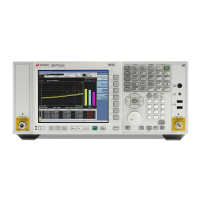
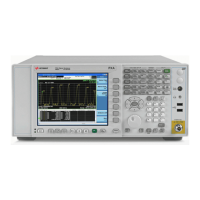

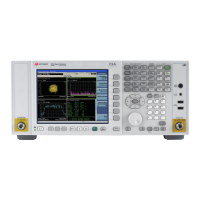

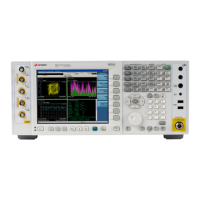



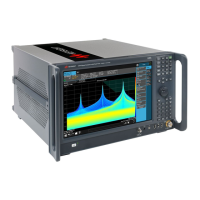
